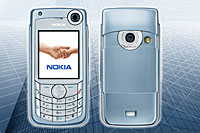 The Nokia 6680 imaging smartphone has been declared the new ‘Best in Class’ 3G device according to a report by Strategy Analytics.
The Nokia 6680 imaging smartphone has been declared the new ‘Best in Class’ 3G device according to a report by Strategy Analytics.
Four of the best 3G devices currently available in Western European were put under the microscope by Strategy Analytics’ Advanced Wireless Laboratory (AWL) panels in London, UK and Milan, Italy.
All of the phones were assessed on four categories: Video Features, User Interface & Input, Display, and Style/Design, with the Nokia reigning supreme in two categories, Display and Style/Design, as well as registering a joint highest score for User Interface.
When the white-coated, clipboard-toting boffins had finished tallying up the scores, the Nokia 6680 was also the only device to score above the mean score across all four categories.
The 6680 achieved a composite mean rating of 73, compared with 71 for the Sony Ericsson V800, 69 for the Motorola E1000 and 64 for the NEC e338.
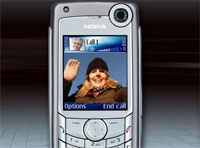 The report noted strong deviations (oo-er!) in the results of these evaluations by gender with the lay-deees preferring the Sony Ericsson and NEC devices, whereas the geezers exhibited a strong preference for the Nokia and Motorola handsets.
The report noted strong deviations (oo-er!) in the results of these evaluations by gender with the lay-deees preferring the Sony Ericsson and NEC devices, whereas the geezers exhibited a strong preference for the Nokia and Motorola handsets.
“This acknowledgment underscores Nokia’s leadership in 3G devices,” purred Joe Coles, Director of imaging product marketing at Nokia. “The Nokia 6680 is an example of an engineering masterpiece that offers very sophisticated technology combined with ease of use and extremely desirable design. Devices like it pave the way for transforming the way people live, work, play and communicate.”
The Nokia scored particularly well in the Style/Design category, with 98% of participants nominating the phone as the ‘coolest’.
Users were also mightily impressed with the clarity, resolution and brightness of the Nokia 6680 smartphone’s display.
The phone’s User Interface and menu system was considered “logical and easy to use” by the majority of users, with the smartphone scoring highest in the exciting sounding categories of ‘Configuration and Usability of Hot-Buttons’ and ‘Ease of switching between text options’ (who dreams these things up?).
Kevin Nolan, Director of Strategy Analytics’ Advanced Wireless Laboratory commented: “As handset manufacturers compete to launch compelling devices that will meet the demands of the advanced buyers who will drive multimedia content consumption across 3G networks, the Nokia 6680 has set a new standard for performance in terms of usability and device size and style.”
 As we announced in March, the Nokia 6680 imaging smartphone comes with a shedload of features including two integrated cameras, a flash, the Nokia XpressPrint printing solution, an active slide for easy camera activation and a bright screen of up to 262,144 colours.
As we announced in March, the Nokia 6680 imaging smartphone comes with a shedload of features including two integrated cameras, a flash, the Nokia XpressPrint printing solution, an active slide for easy camera activation and a bright screen of up to 262,144 colours.
All the vogue Smartphone features are present and correct, with the Nokia sporting an organiser, video streaming, Internet browser, email and 3G-enabled services, such as two-way video calling and video sharing.
As competing handset manufacturers try to catch the eye of consumers by ramping up the gizmos and widgets, it’s important that the phones remain easy to use.
Nokia have acquired a well earned reputation for the simplicity of their interfaces and this writer still rues the day he moved from his Nokia phone to a fiddly-tastic Sony Ericsson.
 Microsoft has released the final version of MSN Desktop Search, offering new features based on extensive user feedback and boasting extended support for file types.
Microsoft has released the final version of MSN Desktop Search, offering new features based on extensive user feedback and boasting extended support for file types. These advanced indexing options also let users specify file types to be indexed as text, create a list of file types that should not be indexed, decide the location of the index file and boost the priority of the indexing process (although this may cause some PCs to run as slow as a tired sloth on Mogadons, but at least it can be turned off).
These advanced indexing options also let users specify file types to be indexed as text, create a list of file types that should not be indexed, decide the location of the index file and boost the priority of the indexing process (although this may cause some PCs to run as slow as a tired sloth on Mogadons, but at least it can be turned off).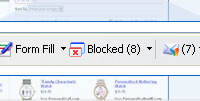 As is the norm with search toolbars, there’s a pop up blocker and form-filler installed, although there’s still no Firefox-style tabbed browsing on offer, although MSN says it will be added soon.
As is the norm with search toolbars, there’s a pop up blocker and form-filler installed, although there’s still no Firefox-style tabbed browsing on offer, although MSN says it will be added soon.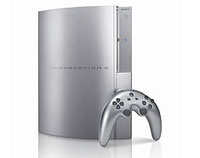 Sony has unveiled prototypes of their new Playstation 3 console at the Electronic Entertainment Expo (E3) in Los Angeles.
Sony has unveiled prototypes of their new Playstation 3 console at the Electronic Entertainment Expo (E3) in Los Angeles. Sony are currently collaborating with the world’s leading tools and middleware companies, to provide developers with extensive tools and libraries to make the best of the Cell processor and enable efficient software development.
Sony are currently collaborating with the world’s leading tools and middleware companies, to provide developers with extensive tools and libraries to make the best of the Cell processor and enable efficient software development. More and more people are using computers or portable players for music, even though traditional radio still leads the competition, according to a recent market study.
More and more people are using computers or portable players for music, even though traditional radio still leads the competition, according to a recent market study. Last week, Yahoo revealed their determination to become big noise in the music industry, unveiling a
Last week, Yahoo revealed their determination to become big noise in the music industry, unveiling a  Shure have just released their E4c earphones. These are the in-ear type with various mouldings (sleeves) that fit on to the actual phones so you can get a comfortable fit.
Shure have just released their E4c earphones. These are the in-ear type with various mouldings (sleeves) that fit on to the actual phones so you can get a comfortable fit.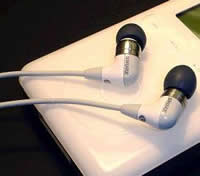 While sitting on the underground you could just hear the station announcements on the public address system, but not much else. The music playing was ambient dance music and you could really make out the nuances etc. Unfortunately the only downside of blotting out everything made you realise even more how miserable everyone looked.
While sitting on the underground you could just hear the station announcements on the public address system, but not much else. The music playing was ambient dance music and you could really make out the nuances etc. Unfortunately the only downside of blotting out everything made you realise even more how miserable everyone looked.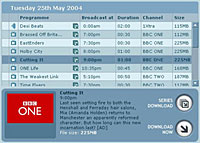 BBC New Media is to extend trials of its interactive Media Player (iMP), allowing viewers to download material from 500 hours of its television and radio programming.
BBC New Media is to extend trials of its interactive Media Player (iMP), allowing viewers to download material from 500 hours of its television and radio programming. The 5,000 trialists will be able to search for programmes they want to watch, filter programmes by channel, select subtitles and, in the case of some series, to collect and watch episodes that they may otherwise have missed.
The 5,000 trialists will be able to search for programmes they want to watch, filter programmes by channel, select subtitles and, in the case of some series, to collect and watch episodes that they may otherwise have missed.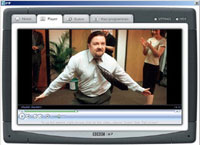 The pilot will use DRM software to delete programmes seven days after the programme has aired on TV, ensuring that users can no longer watch the content after that time. The digital rights system will also prevent users emailing the files to their chums or sharing it via disc.
The pilot will use DRM software to delete programmes seven days after the programme has aired on TV, ensuring that users can no longer watch the content after that time. The digital rights system will also prevent users emailing the files to their chums or sharing it via disc.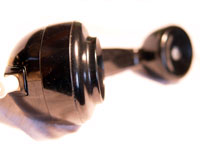 AOL today trumpeted its intention to muscle into the UK phone business with the launch of a home service offering unlimited calls for an introductory flat rate of £7.99 (~US$14, ~€11) per month.
AOL today trumpeted its intention to muscle into the UK phone business with the launch of a home service offering unlimited calls for an introductory flat rate of £7.99 (~US$14, ~€11) per month. Johnny-come-lately subscribers signing up after 30 June 2005 will pay this standard monthly subscription fee.
Johnny-come-lately subscribers signing up after 30 June 2005 will pay this standard monthly subscription fee.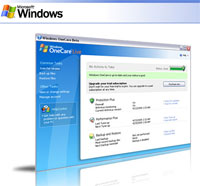 Microsoft has announced that it would begin testing OneCare Live – a PC-health care fix-it all application – with a general release sometime next year.
Microsoft has announced that it would begin testing OneCare Live – a PC-health care fix-it all application – with a general release sometime next year.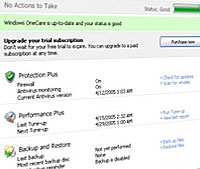 OneCare is a separately sold subscription-based service designed to work as a mainly “hands-off” application, quietly doing its good deeds in the background while sending security updates to users’ computer systems without them having to download or install the fixes.
OneCare is a separately sold subscription-based service designed to work as a mainly “hands-off” application, quietly doing its good deeds in the background while sending security updates to users’ computer systems without them having to download or install the fixes. Natalie Mouyal of
Natalie Mouyal of 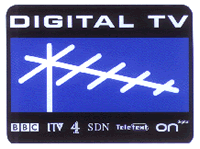 Generally, countries have tended mix the two strategies. Viewers have benefited from both an increase in the number of television service programmes available, as well as interactive television services. Yet, this combination has not always allowed for an impressive take-off of MHP based interactive services. In the case of Finland, consumers could choose between a zapper set-top box that allows them to access more television service programmes or an MHP-enabled set-top box that allows them to access both the increased number of television services programmes as well as the interactive services. However, MHP-enabled set-top boxes make up only 5% of all set-top boxes currently purchased.
Generally, countries have tended mix the two strategies. Viewers have benefited from both an increase in the number of television service programmes available, as well as interactive television services. Yet, this combination has not always allowed for an impressive take-off of MHP based interactive services. In the case of Finland, consumers could choose between a zapper set-top box that allows them to access more television service programmes or an MHP-enabled set-top box that allows them to access both the increased number of television services programmes as well as the interactive services. However, MHP-enabled set-top boxes make up only 5% of all set-top boxes currently purchased. It has been assumed that many consumers will invariably prefer the cheaper zapper set-top box to a more expensive MHP-enabled set-top box. However, this reasoning disregards the type of interactive services offered. For example, should viewers find interactive services compelling and easy to use, they may be willing to spend the extra money necessary for an interactive set-top box. Thus, it would seem that consumer education is key to the successful roll-out of interactive services.
It has been assumed that many consumers will invariably prefer the cheaper zapper set-top box to a more expensive MHP-enabled set-top box. However, this reasoning disregards the type of interactive services offered. For example, should viewers find interactive services compelling and easy to use, they may be willing to spend the extra money necessary for an interactive set-top box. Thus, it would seem that consumer education is key to the successful roll-out of interactive services.